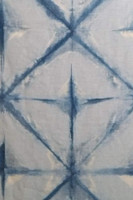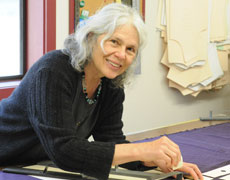How sewing machines are playing a part in climate resilience
Posted by Rose on 17th Mar 2022
A co-op of artisanal clothing makers in Niger depends on sewing to avert poverty in the face of climate change and glaring gender inequality.
In my ongoing celebration of Women’s History Month, this week I turn my attention to a women’s cooperative in Niger where well-worn sewing machines are crucial for survival. In case you missed them, last week we looked at how sewing machines helped democratize Africa. The week before I wrote about the fascinating and troubling history of African wax prints and their connection with the batik workshops of Indonesia and Malaysia.
Halima Ousseïni’s prospects have grown vastly thanks to some new skills and a humble sewing machine. (UNDP)
Niger is a desperately poor place, the second poorest place on earth according to most measures. Struggling with long-term drought, and now the added impacts of climate change, Nigerien women feel those impacts even more acutely as a marginalized group within their society. So it was with great interest I learned about a micro-project of the United Nations Development Program (UNDP) that provides seed money to sewing cooperatives.
In an inspiring UNDP report, we meet Halima Ousseïni, a 16-year-old who had to drop out after two years of secondary school. Her future was bleak. The vast majority of girls are married by 18 and crushing poverty coupled with social repression severely limit women's options. When a UNDP-sponsored sewing cooperative sprung up in Halima’s village, she was quickly on board. Reflecting on how her life has changed, Halima recalls, “I was excluded from school and was doing nothing when I learned through a friend that the project had opened a sewing center to allow women and girls to learn sewing. I was interested and so I enrolled in the center. Since I have been here, I have learned a lot. To sew clothes for myself, for my parents and even for clients.”
Despite a disability, Hadizatou Ebiliki has risen to the presidency of her seamstress co-op while also learning entrepreneurial skills. (UNDP)
Another aim of the project was to assist disabled women, and the story goes on to highlight Hadizatou Ebiliki who is confined to a wheelchair. With her husband often away seeking farm work, she embraced the cooperative movement as a way to avoid becoming a street beggar for sustenance. Instead, today, thanks to new skills and grants she now is not only a successful seamstress, Hadizatou is also the president of her sewing collective. She remembers, "At the beginning, we had a lot of difficulty operating our business. We didn’t have the equipment we needed. Then the project built this nice facility, and gave us training and materials to support us. This support has naturally enabled us to increase our services and improve our incomes. You see that I am a handicapped person, but I am fully in charge thanks to my sewing activity,”

There's a paradox involving sewing technology: The fast fashion industry is enabled by modern machines that churn out products at astonishing speed. It fuels the export of western clothing castoffs back to the developing world, undermining locally made artisanal clothing. I love the fact that far humbler technology that remains essentially unchanged since the mid-19th century continues to make a difference for the better in the lives of women all over the world.
Share:




